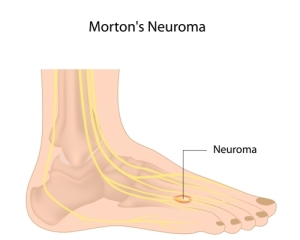Morton’s neuroma occurs at the interdigital nerves and the interdigital arteries are in close proximity at the base of each toe.
With injuries such as somebody stepping onto a toe or with stubbing of a toe the tiny arterial nutritional vessels for the interdigital nerve can get injured. This leads to an inflammatory response with fibrotic changes of the nerve sheath, which in turn leads to a degenerative change of this nerve as a result of the entrapment (Ref. 1, p.18).
75% of the cases occur in middle aged women and the pain is made worse with high heels and a narrow toe box. In about 80% of the cases the location of Morton’s neuroma is in the 3rd toe interspace (between the 3rd and 4th toes), the remainder is found in the 2nd interspace (between the 2nd and 3rd toes).
Tests before surgery
There are anatomical reasons and pressure considerations that lead to this constellation. Tests that are used to diagnose this condition are plain x-rays to rule out other causes for similar pain, a bone scan to rule out Freiberg’s disease and possibly an MRI scan, which can directly show the neuroma.
The MRI scan can be replaced by the more important clinical test of foot pain relief through freezing the neuroma with a local anesthetic. This test will relieve the pain from the Morton’s neuroma temporarily. If it does, this is not only proof of the diagnosis, but also a powerful predictor whether a surgical release will help to cure the problem. Morton’s neuroma surgery will help to cure it in about 80% of cases, but will not help in about 20%. Problem patients are those with diabetes and those with poor circulation as they have problems with healing following surgery. Many surgeons will therefore not do surgery on these patients as the risk is too high.
References
1. ABC of rheumatology, second edition, edited by Michael L. Snaith , M.D., BMJ Books, 1999. Chapter 5.
2. The Merck Manual, 7th edition, by M. H. Beers et al., Whitehouse Station, N.J., 1999. Chapter 270.
3. Wheeless’ Textbook of Orthopaedics: http://www.wheelessonline.com/
4. The Merck Manual, 7th edition, by M. H. Beers et al., Whitehouse Station, N.J., 1999. Chapter 60, p.487.
5. Goldman: Cecil Textbook of Medicine, 21st ed.(©2000)W.B.Saunders
6. Ferri: Ferri’s Clinical Advisor: Instant Diagnosis and Treatment, 2004 ed., Copyright © 2004 Mosby, Inc.
7. Rakel: Conn’s Current Therapy 2004, 56th ed., Copyright © 2004 Elsevier







